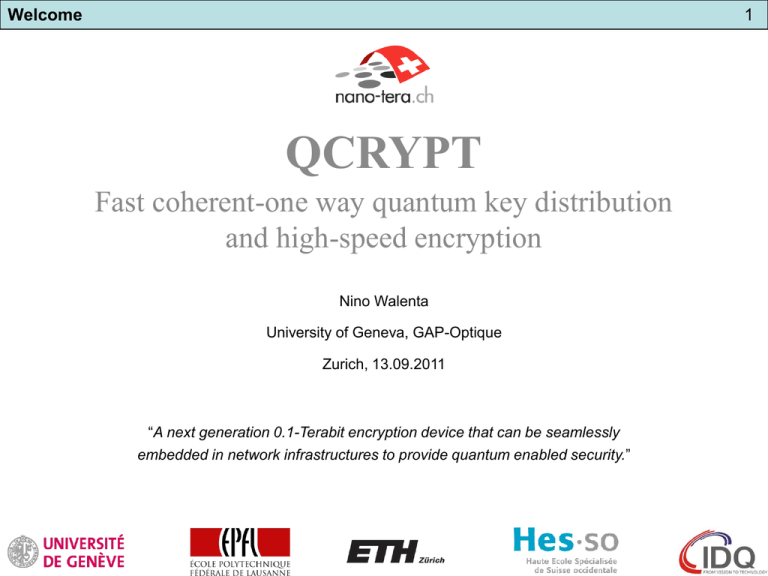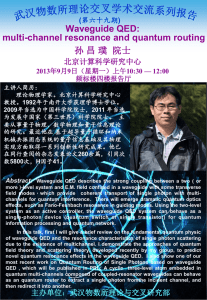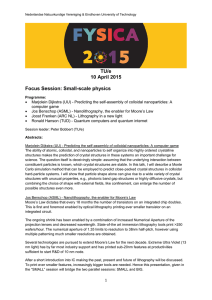Slide - QCRYPT 2011: First Annual Conference on Quantum
advertisement

Welcome 1 QCRYPT Fast coherent-one way quantum key distribution and high-speed encryption Nino Walenta University of Geneva, GAP-Optique Zurich, 13.09.2011 “A next generation 0.1-Terabit encryption device that can be seamlessly embedded in network infrastructures to provide quantum enabled security.” Outline 2 QCRYPT Fast coherent-one way quantum key distribution and high-speed encryption 1. 2. 3. 4. 5. Introduction The QKD engine The hardware key distillation engine The 100 Gbit/s encryption engine Outlook Interdisciplinary competences 3 Interfaces Quantum Key Distribution UNIGE HES-SO Terabit Encryption ETHZ Terabit Quantum Encryption Industry id Quantique Nino Walenta, Charles Lim Ci Wen, Raphael Houlmann, Olivier Guinnard, Hugo Zbinden, Rob Thew, Nicolas Gisin Etienne Messerli, Pascal Junod, Gregory Trolliet, Fabien Vannel, Olivier Auberson, Yann Thoma Norbert Felber, Christoph Keller, Christoph Roth, Andy Burg Patrick Trinkler, Laurent Monat, Samuel Robyr, Lucas Beguin, Matthieu Legré, Grégoire Ribordy QCrypt Specifications 625 Mbit/s clocked QKD 1.25 GHz Rapid gated single photon detectors Hardware key distillation 1 Mbit/s One-Time-Pad encryption 1-fibre DWDM configuration Continuous and reliable operation 4 10 Ethernet channels at 10 Gbit/s 100 Gbit/s AES encryption engine 100 Gbit/s data channel over a single fiber Tamper proof Certification Coherent One-Way quantum key distribution 1. Preparation: Alice encodes information into two time-ordered coherent states 0 : 0 , 2. Measurement: 3. “Sifting”: 4. Post-processing: 5. Authentication: 5 1 : 0 , 0 1 e 2 Coherent One-Way quantum key distribution 1. Preparation: 6 Alice encodes information into two time-ordered coherent states 0 : 0 , 1 : 0 , 0 1 e 2 2. Measurement: Bob measures pulse arrival time (bit value) and coherence between bits (eavesdropper’s potential information about key). 3. “Sifting”: Bob tells Alice publicly, when and in which detector he measured (bit measurement or coherence measurement), incompatible measurements are discarded. 4. Post-processing: 5. Authentication: Coherent One-Way quantum key distribution 7 tB 1. Preparation: Alice encodes information into two time-ordered coherent states 0 : 0 , 1 : 0 , 0 1 e 2 2. Measurement: Bob measures pulse arrival time (bit value) and coherence between bits (eavesdropper’s potential information about key). 3. “Sifting”: Bob tells Alice publicly, when and in which detector he measured (bit measurement or coherence measurement), incompatible measurements are discarded. 4. Post-processing: 5. Authentication: Coherent One-Way quantum key distribution 8 QBER Visibility 1. Preparation: Alice encodes information into two time-ordered coherent states 0 : 0 , 1 : 0 , 0 1 e 2 2. Measurement: Bob measures pulse arrival time (bit value) and coherence between bits (eavesdropper’s potential information about key). 3. “Sifting”: Bob tells Alice publicly, when and in which detector he measured (bit measurement or coherence measurement), incompatible measurements are discarded. 4. Post-processing: Eliminate quantum bit errors and reduce eavesdropper’s potential information about the key. 5. Authentication: Coherent One-Way quantum key distribution 1. Preparation: 9 Alice encodes information into two time-ordered coherent states 0 : 0 , 1 : 0 , 0 1 e 2 2. Measurement: Bob measures pulse arrival time (bit value) and coherence between bits (eavesdropper’s potential information about key). 3. “Sifting”: Bob tells Alice publicly, when and in which detector he measured (bit measurement or coherence measurement), incompatible measurements are discarded. 4. Post-processing: Eliminate quantum bit errors and reduce eavesdropper’s potential information about the key. 5. Authentication: Assure that public communication is authentic. Secret key costs! Coherent One-Way quantum key distribution 10 Advantages of modification No decoy states One-way sifting One basis - no sifting losses More robust against USD attacks No active elements at Bob Robust bit measurement basis Robust against PNS Security proof for zero error attacks and some collective attacks C. Ci Wen Lim, N. Walenta, H. Zbinden. A quantum key distribution protocol that is highly robust against unambiguous state discrimination attacks. Submission in process.. H. Zbinden, N. Walenta, C. Ci Wen Lim. US-Patent Nr. 13/182311. 11 Secret key fraction Security against zero-error attacks Distance [km] 1 ( A : E ) Q (1 Q) h( 1 2 V 1 e 2 V 1 V 1 e 2 Poster session 16:00 - 18:00 C. Ci Wen Lim, N. Walenta, H. Zbinden. A new Coherent One-Way protocol that is highly immune against unambiguous state discrimination attacks. M. Mafu, A. Marais, F. Petruccione. Towards the security of coherent-one-way quantum key distribution protocol. 2 ) 12 DWDM DWDM Dense wavelength division multiplexing Multiplexing classical channels (> -28 dBm) along with quantum channel (< -71 dBm) on 100 GHz DWDM grid Channel crosstalk „Off-band noise“ due to finite channel isolation of the multiplexers Reduced below detector dark counts by MUX channel isolation (-82 dB) Raman scatter Scattering off optical phonons, in forward and backward direction Dominating for fibre lengths > 10 km DWDM impairment sources Channel crosstalk „Off-band noise“ due to finite channel isolation of the multiplexers Reduced below detector dark counts by MUX channel isolation (-82 dB) 13 Raman scatter Scattering off optical phonons, in forward and backward direction Dominating for fibre lengths > 10 km P. Eraerds, N. Walenta et al. Quantum key distribution and 1 Gbps data encryption over a single fibre. NJP 12, 063027 (2010). QKD performance estimates 2-fibre configuration 1-fibre DWDM configuration 14 Fast pulse pattern modulation 15 tfwhm130 ps 250 ps QBER IM 1 IM 2 Pulse amplitude modulation Off-the-shelf components High extinction ratio QBERIM < 0.2 % High visibiliy 625 MHz Pulse pattern repetition frequency V > 0.995 Rapid gated single photon detectors 130 ps 16 QKD performance estimates 7 -1 0.10 Sifted rate Error corrected rate Secret rate 10 Key rates [s ] 100 km 50 km 0 km 0.08 6 0.06 5 0.04 4 0.02 10 10 10 3 10 0 -5 -10 -15 -20 QBER 8 10 17 0.00 Transmission [dB] Rapid gated single photon detectors Low dead time 8 ns Low afterpulse probability < 1% High detection rates > 33 MHz Peltier cooled InGaAs diode Compact design Hardware key distillation engine Sifting 18 Timing and base information Bit permutation Ommited Error estimation Random sampling for QBER Error correction LDPC forward error correction Privacy amplification Error verification Authentication Toeplitz hashing CRC check Polynomial hashing Key size Hardware limits on maximal key length Memory Throughput Sifting channel 19 High detection rate Low detection rate Timing bits, relative to last detection 10 D1 0 0 1 Data detection 0 1 0 IF detection at t1 0 1 1 IF detection at t2 1 0 0 Bit 0 for QBER estimation 1 0 1 Bit 1 for QBER estimation 1 1 1 Include next block D 3 bit, b 5 bit D 3 bit, T 5 bit 104 D 3 bit, T 13 bit 1000 100 10 10 D2 5 108 5 Sifting rate s 1 Sifting bits per detection Indicator bits D3 6 10 5 10 4 4 108 D 3 bit, T 13 bit 3 108 2 108 1 108 0 0.001 0.01 Detection probability 0.1 1 0 20 40 60 80 100 Fibre length km 120 140 LDPC Information reconciliation 20 msynd Low-density parity-check codes • Ensure integrity of secret keys with minimum redundancy through forward error correction and privacy amplification • Theoretically capacity-approaching - practically ressource limited efficiency • Reverse reconciliation • FPGA implementation msynd nsift ec QBER h QBER • Syndrome of length C. Roth, P. Meinerzhagen, C. Studer, A. Burg. "A 15.8 pJ/bit/iter quasi-cyclic LDPC decoder for IEEE 802.11n in 90 nm CMOS," Solid State Circuits Conference (A-SSCC), 2010 IEEE Asian, (2010) Privacy amplification 21 Toeplitz hashing • Alice and Bob have to agree on a randomly selected Toeplitz matrix • k + nsift -1 bits of communication k nsift 1 hQ ( A : E ) nsift ...block length,Q...QBER • Seed of length mPA nsift 2 hQ A : E 1 2 1 ( A : E ) Q (1 Q) h( 1 2 V 1 e 2 V 1 V 1 e ) 2 H. Krawczyk. LFSR-based hashing and authentication. Lecture Notes in Computer Science 839 (1994) C.Branciard et al. Upper bounds for the security of two distributed-phase reference protocols of quantum cryptography. NJP 10, 013031 (2008). Information theoretic authentication Secret bits 22 tag Security length parameter D.R. Stinson. Universal hashing and authentication codes. Advances in Cryptology ‘91. D.R. Stinson. Universal hashing and authentication codes. Designs, Codes and Cryptography, 4 (1994). Information theoretic authentication Secret bits 23 tag Security length parameter Polynomial hashing Construct an almost universal family of hash functions and apply a strongly universal hash function at the end. D.R. Stinson. Universal hashing and authentication codes. Designs, Codes and Cryptography, 4 (1994). 100 Gbit/s Encryption engine 10 x 10 Gbit/s Users interfaces 24 1 x 100 Gbit/s Client interface FPGA design and 100 Gbps Interface User side: 10 x 10 Gbit/s Ethernet channels through 10 SPF+ optical modules Client side: 1 x 100 Gbit/s channel over a single fibre using WDM optical module feeds with 10 x 10 Gbit/s high-speed serial links All synchronization and channels splitting made in the FPGA 100 Gbit/s AES-GCM encryption 25 Key Basic AES: 1 – 2 Gbit/s 20 x pipelining: requires feedback-free Encryption mode 4 x parallelization: data-independent partitioning Counter mode Plaintext Cyphertext Basic Authentication: 4 – 8 Gbit/s Authenticated data and cyphertext 4 x pipelining 4 x parallelization 4 Galois field multipliers (x128+x7+x2+x+1) Two engines for En- and Decryption Authentication tag 100 Gbit/s Fast encryption board 100 Gbit/s Fast Encryption Board PCB: 24 layers, 52 high-speed serial links,10 power supplies Communication links: 22x High-speed serial 6.5 Gbit/s 8x SFP+; 2x XFP 10 Gbit/s 1x CXP; 1x CFP 100 Gbit/s FPGA main power supply: 0.95 V, 40 A 26 Outlook 27 • Real network compatibility and integration • Side channel analysis • Tamper detection • Resistance against detector blinding attack • Certification • Afterpulsing reconcillation Questions, please! 28 • Real network compatibility and integration • Side channel analysis • Tamper detection • Resistance against detector blinding attack • Certification • Afterpulsing reconcillation Thank you for your attention!






